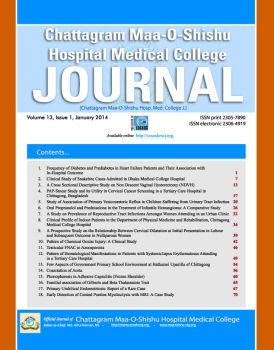A Cross Sectional Descriptive Study on Non Descent Vaginal Hysterectomy (NDVH)
DOI:
https://doi.org/10.3329/cmoshmcj.v13i1.19411Keywords:
Non descent vaginal hysterectomy, abdominal hysterectomy, morcellationAbstract
Aims and objectives: The objective of this study was to determine the less post operative morbidities and better compliance of the patient following vaginal hysterectomy in case of non descent uterus.
Materials and Methods: This is a cross sectional descriptive study of patients admitted in Chittagong medical college Hospital and different private clinics between May 2010 and April 2013. Total 126 patients requiring hysterectomy recruited for the study. Indications of Non-descent vaginal hysterectomy (NDVH) were dysfunctional uterine bleeding ( DUB), fibroid uterus, adenomyosis, chronic cervicitis, CIN- II and III, endomertrial hyperplasia, PID and invasive mole. NDVH were performed in cases with mobile uterus, size not exceding 14 weeks of gestation, and with adequate vaginal access. Morcellation techniques like bisection, myomectomy, wedge debulking or combination of these were employed in bigger and firmer uteri.
Results: Age ranged from 35 -60 years with majority (68.25%) between 45 and 50 years and 8.70% above 50 years. Seventy nine (62.698%) women were of 3 or more parity, 38 cases (30.15%) had two and 9 cases (7.14%) had one. Preoperative uterine size varied from eight weeks size 98 (77.77%), 12 weeks size 21 cases (16.66%) and more than 12 weeks size7 cases (5.55%). Table 1 depicts the indications for NDVH. One hundred nineteen patients had hysterectomy and remaining 7 had hysterectomy with salpingo-oophorectomy. Eighty four (66.66%) operations were complete within 90 minutes and remainder needed 90 minutes to 3 hours. Average blood loss was up to 200 ml in 91 (72.20%) cases and in other cases it was more than 200 ml. Average hospital stay was 2 days in the majority (76.20%) while 3-5 days in others. Bladder injury occurred in 6 cases (4.76%) and rectum injury in 1case (0.79%) during operation. Postoperatively 12 (9.52%) patient were suffering from secondary haemorrhage and 15 (11.11%) patient from vault granuloma. Analgesic requirement was at minimum during post operative period. Cost was reduced with the compared to the other route of hysterectomy.
Conclusion: NDVH is a less invasive technique with benefits,which includes shorter hospital stay and faster convalescence and avoid abdominal wound complications. It should be a primary methods for removal of large uterus provided one is familiar with morcellation technique.
Downloads
901
1212
Downloads
Published
How to Cite
Issue
Section
License
Authors of articles published in CMOSHMC Journal retain the copyright of their articles and are free to reproduce and disseminate their work.
A Copyright and License Agreement -signed and dated by the corresponding author on behalf of all authors -must be submitted with each manuscript submission.

